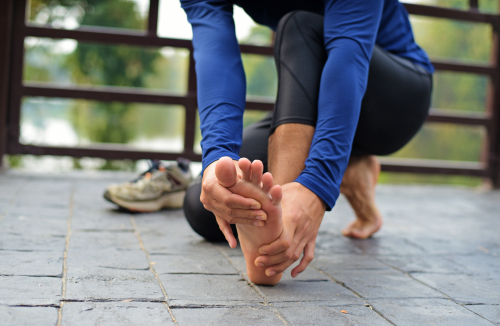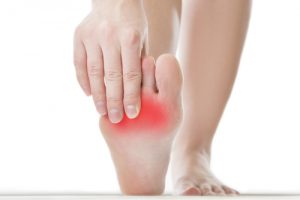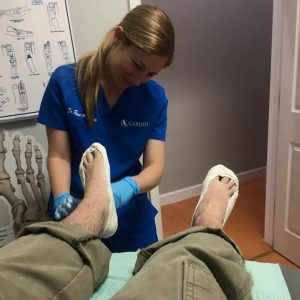
What is a Neuroma?
Basically, a neuroma (commonly called a pinched nerve) is a thickening of nerve tissue. A neuroma can form in various areas of the body, but the most common neuroma in the foot is called Morton’s neuroma. This condition is named after the American surgeon Thomas George Morton (1835-1903) who published the first complete description of this particular neuroma. The term intermetatarsal neuroma describes its most common location between the third and fourth toe bones (metatarsals). 
What Are the Symptoms of Morton’s Neuroma?
A neuroma begins to form as a result of compression or irritation of the plantar nerve. This leads to thickening and swelling of the nerve and, over time, nerve damage. The thickening mass that forms between the metatarsals can cause numbness, pain, a sensation of tingling or burning, or the feeling of having a small pebble lodged under the ball of the foot. 
Who Gets a Foot Neuroma?
Morton’s neuroma frequently happens in women because of their affinity for shoes that expose their toes to excessive pressure – think high heels or narrow toe boxes. High impact activities involving repetitive movements of the forefoot can also result in neuromas – aerobics, tennis, jogging, running. In fact, Morton’s Neuroma is a common problem in runners, especially women runners.
Home Treatment
At the first sign of trouble, don’t ignore the symptoms. Aggressive conservative treatment right at the beginning of the problem may prevent things from getting worse. Ignoring the pain of Morton’s neuroma is not a treatment – the pain is only likely to increase! Try these options first to relieve your pain:
- Modification of the activity causing the neuroma – take a break from running until the pain and irritation subside.
- Icing of the painful area to relieve swelling and pain.
- Over-the–counter anti-inflammatory medications, such as ibuprofen, to reduce pain and swelling.
- Massaging of the affected area to stimulate the nerve tissue and promote healing.
- Use of a neuroma pad placed on the ball of the foot between the appropriate metatarsals. The pad separates the metatarsals, thus reducing irritation to the nerve.
- Strengthening the toe and ankle muscles through exercises can also be helpful.
In-Office Treatment
If you have tried everything and you are still in pain, it’s time to visit our office. Dr. Caruso will examine your foot and advise you of possible treatment options such as:
- Identification of the specific pressure areas and the creation of a semi-permanent orthotic with offloading metatarsal pads.
- Cortisone or a local anesthetic injected into the painful area.
- Alcohol sclerosing injections. This is a minimally invasive technique involving a very low concentration of alcohol with anesthetic injected into the neuroma to degenerate the nerve. The injections are given in a series of about 3-7 injections about 10 days apart.
- Physical therapy prescription. Physical therapy involving stretching and massaging to increase forefoot flexibility by loosening tight ligaments and tendons.
- A custom orthotic specially designed for your foot. This is a more expensive option than a semi-permanent orthotic and involves molding the foot.

Treatment of Last Resort
If less-invasive treatments fail to provide relief, surgery is an option. The downside is that surgery often results in the permanent numbness of one or more toes and it can take up to six months to fully recover. Dr. Caruso will make an incision on the top of the foot and carefully remove the neuroma.
Don’t Wait to Get Help
Frequently, runners tend to ignore their foot pain believing that they can just “run” through it. Unfortunately, when these runners do eventually consult a podiatrist, they present with significant symptoms. Keep in mind that if not treated, Morton’s neuroma can limit your ability to continue running.
This article is part of the Discussion Series on Running Injuries. Please feel free to Contact Us with any questions or you can Make An Appointment to see Dr. Caruso.
